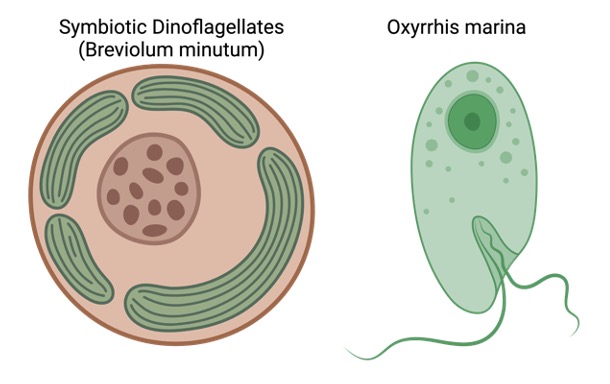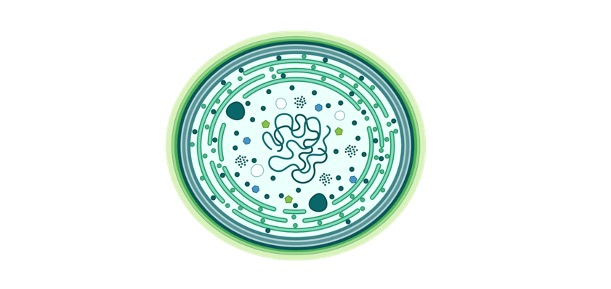Table of Contents
Dinoflagellates Definition
Dinoflagellates are protists which have been classified as approximately half living dinoflagellate species are autotrophs possessing chloroplasts and half are non-photosynthesising heterotrophs.
What are Dinoflagellates?
A flagellate algae with two flagella of uneven length is known as a dinoflagellate. One flagella is tucked inside the body’s groove, while the other extends from the middle. It also possesses a dinokaryon and dinoflagellate toxin, as well as an armor-like shell or pellicle. They are mostly photosynthetic.

Chlorophyll a and c, carotenoids, and xanthophylls are among the pigments found. The carbohydrate reserve is starch, a branching glucose polymer with a molecular weight of α 1-4. Unpigmented protozoa are heterotrophs, meaning they feed on other protozoa. Others are mixedotrophs, meaning they can both photosynthesis and prey on their prey.
Dinoflagellates are members of the Superphylum Alveolata’s phylum Dinoflagellata. They may be found in both freshwater and marine environments. The majority of the species discovered are marine (about 1500-1700). A total of 220 freshwater species have been identified. The size of their population is determined by nutrition availability, salinity, and sea surface temperature.
Dinoflagellates Classification
Algae and protozoa are classified as Kingdom Protista in the five-kingdom categorization system. They differ from protozoa in that they are photosynthetic. Euglenophyta, Chrysophyta (diatoms), Dinoflagellata (dinoflagellates), Chlorophyta, Charophyta, Phaeophyceae, and Rhodophyta are the different categories of algae.
Traditional categorization includes the Cyanophyta or blue-green algae, which are prokaryotic creatures, but in contemporary taxonomy, they are now included alongside bacteria under Kingdom Monera.
It should be noted, however, that organisms’ taxonomic categorization is subject to change when further research into the species leads to the development of newer classification systems, such as those found in the NCBI taxonomy database.
The following are the various classes that make up the phylum Dinoflagellata:
Dinophyceae, Duboscquellea, Ellobiophyceae, Noctiluciphyceae, Oxyrrhea, Pronoctilucea, Psammosea, and Syndiniophyceae are the family names.
General Characteristics of Dinoflagellates
i. Fllagella
Dinoflagellates are unicellular creatures with two flagella: one transverse and one longitudinal. The transverse flagellum is a flat, wavy, and ribbonlike structure that crosses the cingulum, a transverse surface groove. It has an axoneme running through it. This flagellum is in charge of the dinoflagellate’s forward movement, as well as turning and manoeuvring.
The hair on the longitudinal flagellum is sparse to non-existent. It is found in the sulcus, or surface groove. The whipping action is caused by this flagellum, which propels the dinoflagellate in the opposite direction. The name of the group comes from the combined motions of the two flagella, spinning and whipping.
ii. Amphiesma
Amphiesma, a cell covering seen in dinoflagellates, is another distinguishing feature. Alveolae are flattened vesicles that make up the cell envelope. Some flagellates have an external armour called a theca (or lorica).
iii. Dinokaryon
Their nucleus is a distinguishing characteristic as well. Their nucleus is distinguished by fibrillar chromosomes that are linked to the nuclear membrane and stay compacted even throughout the interphase, earning them the name dinokaryon. Their chromosomes are devoid of centromeres and may contain very little or no protein.
Dinoflagellates have a distinct family of nucleoproteins linked to DNA than histones. The nucleoproteins are thought to have come from a virus. As a result, they’re known as dinoflagellate/viral nucleoproteins (DVNPs). The nuclear envelope remains intact throughout mitosis. It does not disintegrate like it does in most eukaryotes.
To coordinate chromosomal segregation, the spindle must go across the nucleus. Dinoflagellates are classified as mesokaryotic because their nuclear characteristics appear to move from prokaryotes to eukaryotes.
iv. Large Genome
Dinoflagellates have a huge genome, ranging from 3 to 250 pg DNA per cell, compared to 0.54 pg DNA per cell in other algae.
v. Pigments
Photosynthetic dinoflagellates have chlorophyll a and c2, xanthophylls, and carotenoids. Chlorophyll pigments are housed in a triple-membraned chloroplast (as opposed to the double-membraned chloroplast seen in plants).
Dinoflagellate chloroplasts may have their own nucleus. Peridinin, dinoxanthin, and diadinoxanthin are the most common xanthophylls. These pigments are responsible for the golden brown hue of certain dinoflagellates.
vi. Eyespot and Ocellus
Dinoflagellates contain an organelle called eyespot that detects light. Inside the layered layers of membranes where the carotenoids are deposited are lipid droplets. As a result, this organelle may identify the light source’s direction. The ocellus, seen in some dinoflagellates, is a highly sophisticated uncommon structure that uses a refracting lens to concentrate an image on the retinoid lining membrane.
vii. Food Reserve and other Cytoplasmic Structures
Starch, carbs, and oils are used to preserve food reserves. A pustule is a noncontractile vacuole found at the flagellar base. One or more vesicles may be present. Flotation and osmoregulation may be aided by pustule. There are no contractile vacuoles.
Dinoflagellates Life Cycle
The majority of dinoflagellates have a haplontic life cycle. This indicates that the zygote (2n) produced via karyogamy splits meiotically right away, resulting in haploid (n) cells. After that, the haploid cells divide mitotically to produce new haploid cells. Haploonts are haploid cells that result after mitosis.
Desmoschisis or eleuteroschisis are two types of asexual reproduction in haplontic dinoflagellates. Desmoschisis occurs when a parent cell splits into two daughter cells, each of which retains half of the parent’s theca. The parent cell sheds its theca (via ecdysis) before dividing into two daughter cells in eleuteroschisis.
The zygote in sexually reproducing dinoflagellates may go through a resting period before becoming a hypnozygote. The hypnozygote is known as a dinocyst in dinoflagellates. The hatchling goes through meiosis inside the cyst to create haploid cells.
Dinoflagellates Evolution
The dinoflagellates’ triple-membraned chloroplasts appear to imply another type of endosymbiotic occurrence in which they may have swallowed a photosynthetic eukaryote. The presence of additional algal pigments like fucoxanthin in the dinoflagellates Karenia spp. is another indicator of probable endosymbiotic processes.
Dinoflagellates Ecology
Dinoflagellates thrive in watery environments. They develop endosymbiotic relationships with other species, such as the dinoflagellate Symbiodinium and corals that construct reefs. Dinoflagellates can eat in a variety of ways. They are phototrophic in certain cases and heterotrophic in others.
Others, referred to as mixotrophic, are a combination of the two types. Food is ingested through the sulcus by those who feed on other species. They could eat other dinoflagellates, algae, bacteria, and other organisms.
Algal blooms are linked to several of them. An algal bloom is exemplified by the red tide phenomenon. It is most common in maritime environments. When some dinoflagellate species grow at a higher pace than usual, this is known as hypergrowth.
The toxin dinoflagellate toxin is a powerful neurotoxin that inhibits the production or release of acetylcholine. The poisons produced by Gymnodinium and Gonyaulax, which create red tide, can be deadly if ingested by filter-feeding mollusks. Peridinium is another frequent genus.
However, not all blooms are harmful. Algal blooms with bioluminescent dinoflagellates produce a blue dazzling burst of light in the ocean. Bioluminescence is a property of around 18 genera of dinoflagellates.
Scintillons are cytoplasmic structures encapsulating the luciferase enzyme and luciferin protein (chlorophyll-derived tetrapyrrole ring). They employ bioluminescence to protect themselves from predators.
Dinoflagellates Citations
- Translation and Translational Control in Dinoflagellates. Microorganisms . 2018 Apr 7;6(2):30.
- Omics Analysis for Dinoflagellates Biology Research. Microorganisms . 2019 Aug 23;7(9):288.
- Cyst-forming dinoflagellates in a warming climate. Harmful Algae . 2020 Jan;91:101728.
- Figures are created with BioRender.com







